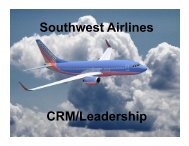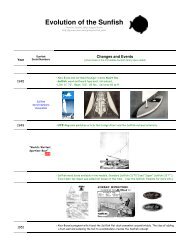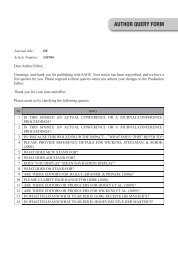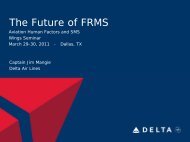Human Factors Checklist - signalcharlie
Human Factors Checklist - signalcharlie
Human Factors Checklist - signalcharlie
You also want an ePaper? Increase the reach of your titles
YUMPU automatically turns print PDFs into web optimized ePapers that Google loves.
<strong>Human</strong> <strong>Factors</strong> <strong>Checklist</strong> <br />
By Dr Anthony Ciavarelii and <br />
Thomas Sather <br />
Naval Postgraduate School <br />
Adapted by Kent Lewis <br />
Signal Charlie
Sensory‐Perceptual <strong>Factors</strong> <br />
• Misjudged distance, clearance, alGtude, <br />
speed, etc… <br />
• False PercepGons due to visual illusion <br />
– Contributory condiGons: <br />
• Featureless terrain (desert, water, dry lakebed) <br />
• Dark <br />
• Black hole approach <br />
• No/false horizon <br />
• Mountainous terrain or sloping runway <br />
• Rotor downwash effects
• Rotor downwash effects <br />
• Anomalous light effects <br />
• Low contrast object or poor illuminaGon <br />
• Looking into bright sun or shadows <br />
• False percepGon due to vesGbular illusions <br />
– Coriolis cross coupling (spining sensaGon due to vesGbular <br />
oversGmulaGon) <br />
– Somatogravic (g induced false pitch up or down) <br />
– Somatogyral (false sensaGon of angular rotaGon) <br />
– G excess ( error in perceiving actual angel of bank)
• SpaGal DisorientaGon/VerGgo <br />
– Type I: Unrecognized or misoriented (loss of <br />
aVtudnal orientaGon without awareness) <br />
– Type II: Recognized (verGgo or the leans) <br />
– Type III: IncapacitaGng (e.g. g‐induced vesGbular‐<br />
ocular coupling) <br />
• CondiGons that affect sense of body posiGon or aircraX <br />
aVtude: <br />
1. Loss of visual cues/aVtude references <br />
2. AcceleraGon related illusions <br />
3. Adverse physiological condiGon (drug, dehydraGon, <br />
faGgue)
• Loss of SituaGonal Awareness <br />
– Types: <br />
1. Geographic disorientaGon (off navigaGon route or <br />
map, lost) <br />
2. General loss of SA (did not perceive hazards) <br />
3. Erroneous situaGon assessment (misinterpreted <br />
situaGon or condiGon) <br />
4. Perceptual tunnelling <br />
5. Failed to predict or anGcipate changing condiGons <br />
6. False hypothesis <br />
7. ConfirmaGon bias <br />
8. Workload task/Gming
• AdenGon Failure <br />
– Types: <br />
1. Missed flight checklist items, callout or crew <br />
challenge <br />
2. Failed to monitor flight progress or maintain <br />
instrument scan <br />
3. Failed to respond to communicaGons or warning <br />
4. Control acGon errors (motor response slip or <br />
memory lapse) <br />
a) Forgot to set/move/reset switch (lapse) <br />
b) UnintenGonal acGvaGon (slip) <br />
c) Control subsGtuGon (slip) <br />
d) Control reversal (slip) <br />
e) Control adjustment/precision error (slip)
CondiGons that influence AdenGon and SituaGon Awareness <br />
1. InadenGon <br />
2. Channelized or task fixated (perceptual narrowing) <br />
3. DistracGon (internal, external) <br />
4. Task overload (excess tasking with/without mission <br />
performance Gme pressure) <br />
5. CogniGve workload (problem solving workload or informaGon <br />
overload) <br />
6. HabituaGon (old/previous learned habit interference) <br />
7. Excess stress or faGgue <br />
8. Excess mission tasking or workload <br />
9. Inadequate briefing or poor flight preparaGon <br />
10. Inadequate training or experience for the mission <br />
11. NegaGve learning transfer (i.e. new aircraX transiGon) <br />
12. Adverse weather/meteorological condiGons <br />
13. Advers cockpit environmental condiGons <br />
14. TacGcal situaGon or display informaGon overload <br />
15. Low aircrew moGvaGon or poor flight vigilance <br />
16. Poor cockpit design (control display locaGon or data format)
Sensory‐Perceptual Risk Management <br />
• Provide conGnued educaGon for pilots and air <br />
safety reps <br />
• Engage FAA AMEs and industry aeromedical <br />
organizaGons <br />
• Establish weather go/nogo decision criteria <br />
• UGlize mission analysis matrix <br />
• Establish SOPs and protocols for known high <br />
risk missions (night, weather, faGgue, training)
Medical and Physiological <strong>Factors</strong> <br />
• Self Medicated <br />
• Under influence <br />
• Known illness <br />
• Excess personal stress <br />
• FaGgue <br />
• NutriGon <br />
• G‐LOC or g excess <br />
• Hypoxia or hypervenGlaGon <br />
• Other
– CondiGons that lead to adverse medical/<br />
physiological state <br />
1. Mission faGgue (on duty over 12 hours, late <br />
night or early morning 0200‐0600 <br />
2. CumulaGve faGgue (excess physical or mental <br />
workload, circadian disrupGon or sleep loss) <br />
3. CumulaGve effects of personal or occupaGonal <br />
stress (exceeds personal coping limits) <br />
4. Emergency flight condiGon/workload transiGon <br />
5. Medical or physiological precondiGons <br />
(preceding state of health, fitness level, <br />
hangover, dehydraGon, etc…)
Medical and Physiological Factor <br />
Risk Management <br />
• Document medical and physiological <br />
qualificaGons <br />
• Protect aviators under high stress due to <br />
human factors <br />
• Share human factors hazard reports of <br />
physiological incidents <br />
• Use aeromedical team resources <br />
• Use CIRP and EAP
Knowledge or Skill <strong>Factors</strong> <br />
• Inadequate knowledge of systems, procedures <br />
(Knowledge based error) <br />
• Poor flight control, airmanship or poor accuracy of <br />
flight maneuvering (Skill based error) <br />
• Misuse of rules or incorrect performance of cockpit <br />
task (Rule based error) <br />
– Types: <br />
A. Failed to perform required procedure(s) <br />
B. Used wrong procedure or rule(s) <br />
C. Missed step(s) in a prescribed sequence <br />
D. Performed steps out of sequence
• CondiGons that lead to poor operaGonal performance <br />
1. Below required proficiency or currency standards <br />
2. Poor performance trend and/or documented flight <br />
apGtude deficiencies <br />
3. Low flight hours (total or in type model) <br />
4. Lacked essenGal training for specific tasks <br />
5. Lacked recent mission or flight condiGons <br />
(instrument, night, weather, etc) <br />
6. TransiGon pilot <br />
7. Marginal Aviator (documented history of poor <br />
performance or flight violaGons)
Knowledge and Skill Factor <br />
Risk Management <br />
• Establish proficiency and currency standards <br />
• Enforce standards in a just manner <br />
• Assess training program against standards <br />
• Document training results <br />
• Use remedial training <br />
• Remove or protect marginal aviators
Personality and Safety AVtude <br />
• Padern of overconfidence <br />
• Padern of excess moGvaGon <br />
• Anger or job frustraGon <br />
• Hot dogging <br />
• AsserGve or non‐asserGve <br />
• Lacked confidence to perform task or mission <br />
• Yielded to operaGonal pressure to perform in <br />
hazardous situaGon (from command or peers)
• ContribuGng factors that lead to poor safety aVtude <br />
1. Habitual high risk taker <br />
2. Overconfidence <br />
3. Marginal or high risk aviator <br />
4. Excess moGvaGon (no limits) <br />
5. Poor command climate or safety culture (lack of <br />
adequate supervision)
Personality and Safety AVtude <br />
Risk Management <br />
• IdenGfy chronic high‐risk takers <br />
• Use judicious crew assignment and scheduling <br />
• Conduct periodic human factors review <br />
• Use <strong>Human</strong> <strong>Factors</strong> Board to manage at risk <br />
aviators
Judgment and Risk Decision <strong>Factors</strong> <br />
• Knowingly accepts high risk situaGons <br />
• Misjudged actual risk of mission (complacency) <br />
• Did not monitor flight progress/condiGons <br />
• Incorrect task prioriGes <br />
• Knowingly deviated from safe procedure <br />
• IntenGonally violated safety standard or regulaGon <br />
• Knowingly exceeded personal limits <br />
• Knowingly exceeded aircraX limits <br />
• Knowingly exceeded prescribed mission parameters <br />
• Yielded to social pressure
• CondiGons that contribute to inappropriate risk <br />
judgment <br />
1. Hotdog or high risk aviator <br />
2. Excess moGvaGon <br />
3. Uncontrolled life stress <br />
4. Too asserGve or non‐asserGve interpersonal style <br />
5. Influenced by poor command climate or safety <br />
culture (lack of adequate supervision)
Judgment and Decision Factor <br />
Risk Management <br />
• Enforce go/no‐go criteria <br />
• Illustrate judgment by example <br />
• Provide crew judgment training and <br />
evaluaGon <br />
• Monitor and correct high risk behavior <br />
• Develop personal SOPs (mins)
Crew CoordinaGon <strong>Factors</strong> <br />
• Inadequate mission plan, brief or preflight <br />
• Failed to communicate plan or intenGons <br />
• Failed to use standard language <br />
• Misunderstood or unacknowledged <br />
communicaGons (readback hearback) <br />
• Inadequate challenge, crosscheck or monitoring <br />
• Withheld vital safety data <br />
• PIC failed to lead and delegate <br />
• PIC failed to use all available resources <br />
• Interpersonal conflict
• CondiGons that contribute to poor crew coordinaGon <br />
• Inadequate training in communicaGons and crew <br />
coordinaGon <br />
• Inadequate SOP for use of crew resources <br />
• Weak support from command for aircrew coordinaGon <br />
doctrine <br />
• Aircrew/cockpit rank and experience gradients <br />
• Command safety culture does not support crew <br />
concept
Crew CoordinaGon Factor <br />
Risk Management <br />
• Establish CRM protocols and SOPs <br />
• Provide CRM (Team) training <br />
• Construct mission task SOPs (crew tasks) <br />
• Brief and debrief CRM events (ASRS) <br />
• Use specific training to teach and learn CRM <br />
tasks and skills
Design and System <strong>Factors</strong> <br />
• Used wrong switch, lever or control <br />
• Misread or misinterpreted instrument reading <br />
• Could not reach or see control <br />
• Could not see or read instrument or indicator <br />
• Failed to respond to warning signal or wrong <br />
response <br />
• Mode confusion <br />
• AutomaGon complacency or fascinaGon
CondiGons that contribute to design‐induced errors <br />
1. Poor primary aircraX controls or display arrangement <br />
2. Inadequate primary data display or data format <br />
3. Hard to read instrument data (Text size, font, color, glare, <br />
lighGng) <br />
4. IncompaGble cockpit control display acGvaGon or response <br />
5. Inadequate hazard advisory or warning display <br />
6. Poor cockpit design layout (vision, reach) <br />
7. Poor human computer display interface/usability (error‐<br />
prone design) <br />
8. Poor systems instrucGon <br />
9. Inadequate aviaGon systems support or faciliGes (nav aids, <br />
airport, air traffic control) <br />
10. Non‐standard cockpit layout <br />
11. Inappropriate type or level of automaGon, or excess <br />
operaGonal mode complexity
Design and Systems <strong>Factors</strong> <br />
Risk Management <br />
• Train and test aircraX systems knowledge <br />
• Fly by the book <br />
• IdenGfy aircraX limits and tolerances <br />
• IdenGfy faulty cockpit layout, control and display <br />
designs <br />
• Publish hazard reports and recommend design <br />
changes Flight Ops <br />
• Consider Airports, ATC, Manufacturers (AircraX, <br />
Engines, Avionics…), Contractors
Supervisory <strong>Factors</strong> <br />
• Inadequate schedule or crew assignment <br />
• Failed to monitor crew rest/duty <br />
• Failed to establish adequate standards <br />
• Failed to monitor compliance to standards <br />
• Failed to monitor crew qualificaGon/training <br />
• Failed to screen/remove high risk aviators <br />
• Failed to establish/monitor quality standards <br />
• IntenGonally violated or directed others to vioate standards, rule or <br />
regulaGon <br />
• Command failed to monitor, perceive and assess actual mission <br />
risks, with respect to: <br />
– Environmental hazards and operaGng condiGons <br />
– Mission tasking and aircrew skill level <br />
– Aircrew, and system limitaGons (AircraX, maintenance, Airports, ATC, <br />
Dispatch, flight ops
• CondiGons contribuGng to supervisory failures <br />
1. Excess ops tempo, organizaGonal workload (imposed by <br />
command or system) <br />
2. Poor command safety climate/culture, lax safety supervision <br />
3. Inadequate standards and/or low performance expectaGons <br />
4. Command did not provide adequate resources to support safe <br />
mission accomplishment <br />
5. Command did not adequately train the mishap pilot or crew <br />
6. Commanders did not set a good example, or set a bad example <br />
7. Supervisors did not provide adequate commitment or emphasis <br />
on safe operaGons <br />
8. Command has poor communicaGons up/down command chain <br />
9. Command has no system o weak system for management of <br />
high risk aviator <br />
10. Command has weak process for operaGonal risk management <br />
11. Command did not provide adequate aeromedical of human <br />
factors training <br />
12. Command did not enforce aeromedical standards
Supervisory Factor <br />
Risk Management <br />
• Establish posiGve command climate <br />
• Set the safety example <br />
• Include safety advocacy as organizaGonal goal <br />
• Set clear performance standards <br />
• Monitor compliance to SOPs <br />
• Know yourself and your team <br />
• Keep an open door and open mind <br />
• Correct poor performance and non‐compliance <br />
• Reward safe behavior <br />
• Embed risk management
• ProducGon <br />
OrganizaGonal <strong>Factors</strong> <br />
• “Risk Management”
• ProducGon <br />
• ProtecGon <br />
Regulatory <strong>Factors</strong> <br />
• Probable Cause paradigm
References <br />
• <strong>Human</strong> <strong>Factors</strong> <strong>Checklist</strong>: An AircraX Accident <br />
InvesGgaGon Tool, Appendix B: Crew Resource <br />
Management <br />
(Naval Postgraduate School, School of AviaGon <br />
Safety, Ciavarelli & Sather, 2002) <br />
hdps://www.netc.navy.mil/nascweb/sas/files/<br />
hfchklst.pdf
Thank you for your dedicaGon to the conGnuous <br />
improvement of aerospace safety <br />
Kent Lewis <br />
kent.lewis@alpa.org <br />
lewis.kent@gmail.com <br />
(817) 692‐1971







